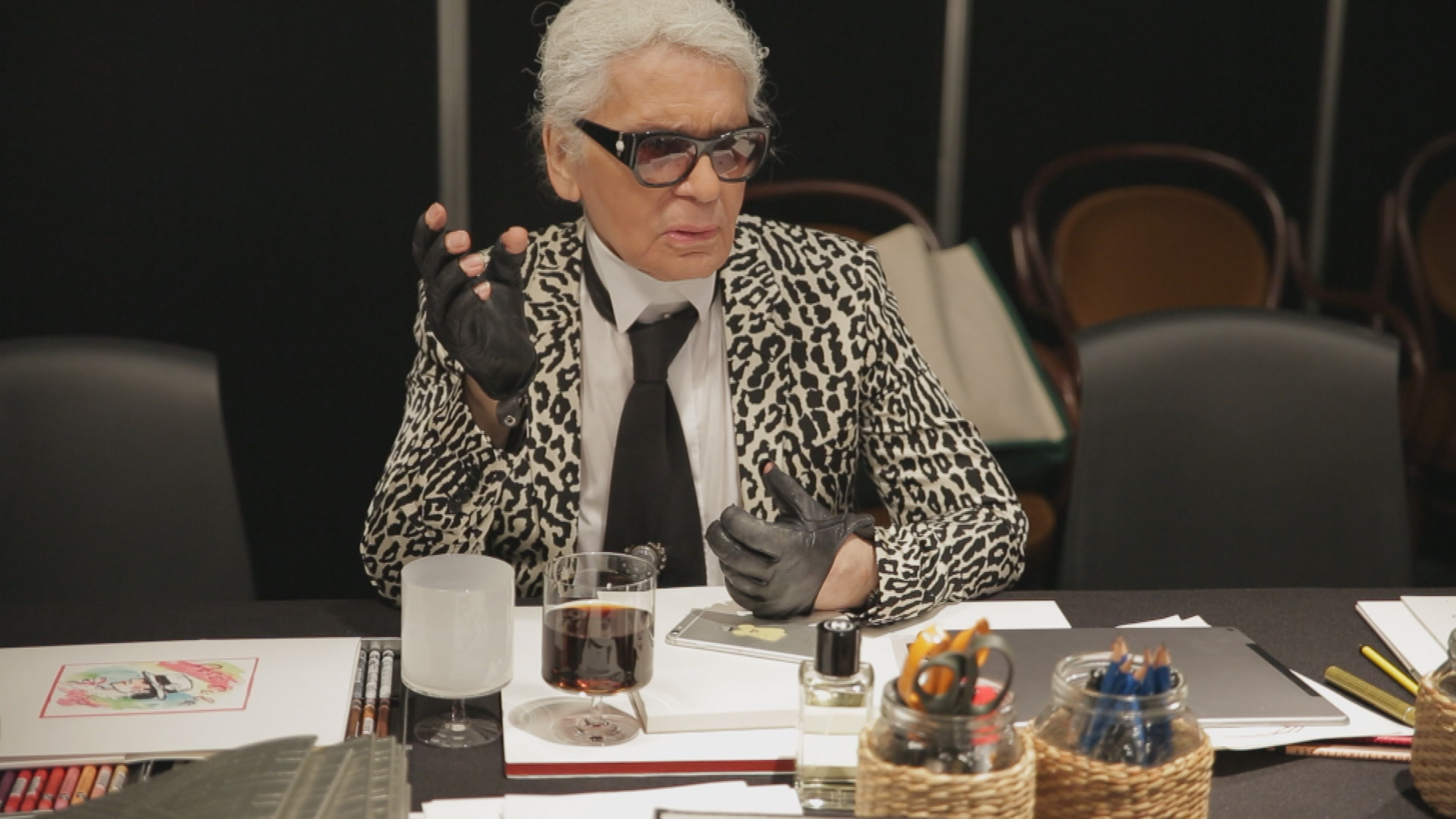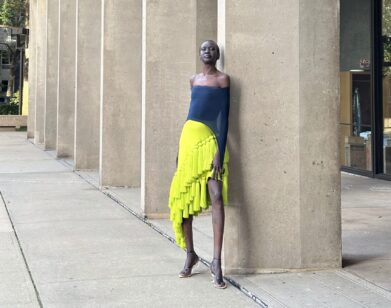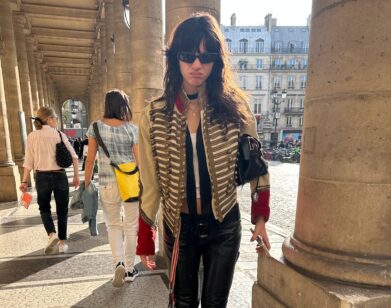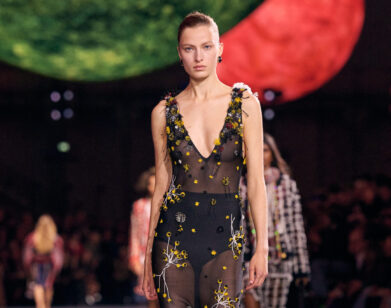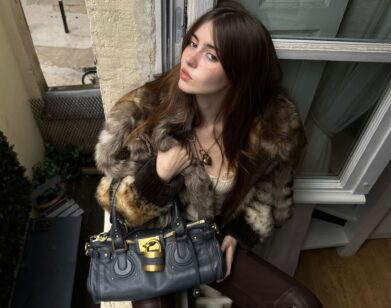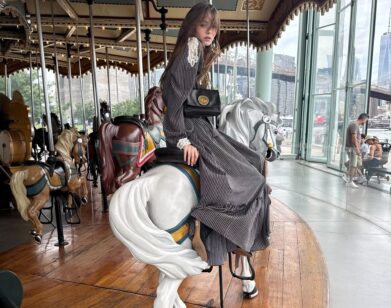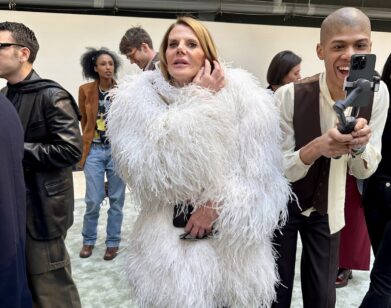KAISER
Andrew Bolton and Loïc Prigent Capture the Luminosity of Karl Lagerfeld
After completing the text to accompany the Met Costume Institute’s spring 2023 exhibition Karl Lagerfeld: A Line of Beauty, head curator Andrew Bolton called up his friend and collaborator, the famed fashion documentarian Loïc Prigent, at his home in Paris. Over the course of their 45-minute conversation, the duo opened up about their personal relationships with Karl, and why it’s his skills, not showmanship, that should dominate the discourse around the creative director’s legacy.
———
WEDNESDAY 4 PM FEB. 15, 2022 NYC
ANDREW BOLTON: Hi, Loïc.
LOÏC PRIGENT: Bonjour. How was it to get a Valentine’s gift at the Thom Browne show yesterday?
BOLTON: Oh my gosh. [Laughs] I saw Thom [Bolton’s husband] coming out with a box of chocolates, and thought, “That’s so sweet.” Then I thought, “Wait, are they for me?” It was like being proposed to in public.
PRIGENT: I saw it trending everywhere. It was the first time I ever commented, “Aw,” on a Vogue post. What did you give him for Valentine’s Day?
BOLTON: I completely forgot it was Valentine’s Day because my mind is so—I wrote my last word at 4:30 last night. I’m exhausted, but the book is finished and I can now focus on everything else.
PRIGENT: How Karl-ified are you?
BOLTON: I basically shut myself off for six weeks to do the writing. It was odd—I feel very, very close to Karl. I’m sure you felt the same when you were working on your documentary with him.
PRIGENT: When you’re editing, you are in his head. My point of view was to let him talk and never contradict him. If he wanted to have a fantasy, if he wanted to invent anything, I would be like, “Go on.” Because it would be his truth and his truth was good enough.
BOLTON: The arc of it was extraordinary, and as you know, it inspired the show.
PRIGENT: I can’t believe it.
BOLTON: There was a quote I came across recently, and it reinforced the conversation that we had in New York, where you were talking about how his drawings were like secret messages to his premieres [patternmakers]. A lot of designers use sketching as a critical process, not as an end in itself. Whereas what Karl ends up with is both a technical drawing and an expressionistic drawing at the same time. I found this eight-page letter he wrote to his mom after he won first place in the Woolmark Prize coat category in 1954. He basically said that his coat design was the best, much better than Saint Laurent’s [who won the dress category that year] because he conceived of it three-dimensionally. His drawing had a front and a back, whereas Saint Laurent’s only had the front.
PRIGENT: And because of you, I was able to film the recreation of the toile of that coat.
BOLTON: It’s a crescendo in your film. It was interesting, in that letter he said he was the only winner who actually went to the fittings. Even in 1954, at the age of 21, he had that hands-on, Protestant work ethic that he had throughout his whole career. In his mind, that’s why he was better than Saint Laurent.
PRIGENT: But if you’re a 21-year-old German in France in 1954, you better have a good work ethic, because nobody liked you. The Germans were not welcome yet, it was too soon. Which birth date are you giving to Karl? Because he lied so much about that.
BOLTON: His real one, ’33. In one of his biographies the writer said that Karl didn’t lie about his age to make himself look younger. Karl lied about his age so that it wouldn’t locate him within Germany during that period of time.
PRIGENT: He talked to me about that period once at a Christmas dinner. Suddenly, he started talking about lots of anecdotes about the war years, intense stuff, and I was really surprised, because I wouldn’t bother him with those questions.
BOLTON: He was so complex.
PRIGENT: Yes. If you put the fake birth year on the label I’d like it better.
BOLTON: I should have one label that says ’33, and one that says ’38, so people are like, “What?”
PRIGENT: I think that’s a good starting point.
BOLTON: Yes. Well, the whole show really was inspired by the videos I saw of yours at the memorial service. The soul of that event was your videos of Karl talking to the premieres. Subsequently, I saw your video of Karl sketching, which I found so moving. It’s like a modernist brushstroke. When I was writing my introduction, I was asking myself: How do you do an exhibition on someone who had a 65-year career? How do you do a show on somebody who worked for four labels, plus his other freelance work? How do you do a show on somebody who is a photographer, a writer, a collector, and basically a polymath? Who was a chameleon? Who was a zeitgeist?
PRIGENT: Right.
BOLTON: That exhibition could have gone anywhere, and I hope somebody else will do another show that’s more comprehensive. This one is just an essay on Karl and his creative process. It’s about the transition from a two-dimensional sketch into a three-dimensional garment, how Karl saw something, and how it was realized at the end. In a way, it’s a one-note show, but it’s also a really in-depth essay in terms of how you translate that into these dualities in his work—like male-female, the street and the salon, floral and graphic. The split personality of Karl.
PRIGENT: I always was amazed by how people wanted to interview Karl, the superstar, and never talk about fashion, when fashion was his core.
BOLTON: You met him in 1997.
PRIGENT: Oui. I think I insulted him the first time I met him. It was a good way to introduce myself.
BOLTON: What was the meeting like?
PRIGENT: Very brief. It was backstage after a ready-to-wear Chanel show, and I think it was in the middle of a big shift at the studio. Gilles Dufour [Karl’s right-hand at Chanel for 15 years] might have been on leave at that point. I asked a question about the logo and the buttons on the Chanel suit of that season. His response was like a slap in the face: “It doesn’t need logos to be Chanel and recognizable!” When I asked him to film Signé Chanel [Prigent’s mini-docuseries about the brand], the lunch lasted until 5 in the afternoon, which is very late for my standards. After three hours of talking I was in a panic. Will he say yes or will he say no? I had to ask Caroline Lebar, his right hand, to ask him.
BOLTON: What did you guys talk about?
PRIGENT: He had really good gossip about Alain Delon [the French actor and filmmaker]. Stuff that Mel Ottenberg would love to learn. And about Madame Palatine, mixed with gossip about 1925 designers. And he was never mean. Maybe he didn’t want to be mean in front of me, but it was always a really good conversation. The best evenings I had with him were when he had a new movie. He would tell me all the details of all the characters. Like, “Oh, this time, Amanda Harlech has a lesbian lover, she is modeled after Marguerite [Dumont], who was a lover of—”
BOLTON: I always found his films so pure, didn’t you?
BOLTON: Yeah. His work is quite childlike in its innocence sometimes. But you knew him before he had his transformation.
PRIGENT: Yes. I remember asking him, “Are your clothes sew-to-measure?” And he said, “You can’t measure me,” or something like that. [Laughs] Actually, the first time he transformed himself, I was working for a TV channel in France and they asked us not to broadcast the Chanel show that season, because they thought he was sick.
BOLTON: Really?
PRIGENT: He hadn’t come out of the diet closet at that point, and they were like, “He must be sick.” Because it was so radical.
BOLTON: So radical.
PRIGENT: He was so childlike. I remember filming him eating out of a bowl, and it took him 32 seconds to finish his lunch.
BOLTON: The first time I met him was in 2005 for the Chanel exhibition we were working on. Somebody would come in every 30 minutes with a new Diet Coke and a pot of chocolate mousse.
PRIGENT: I think it was a mix of proteins and stuff. That was the thing I saw him eat in 32 seconds.
BOLTON: He ate as quickly as he spoke.
PRIGENT: Exactement. He was quick with everything. The way he drew was so amazingly quick. That’s why I wanted to do the documentary, because I saw how he expressed himself through drawings. When there was a technical mystery during the fittings, he would draw something that was half abstract, half genius, and everybody would understand the 3D image in his mind right away. But he would put everything in the bin.
BOLTON: He would be there with the toile, and instead of just touching it and saying, “Two millimeters here,” he would take his pen and paper and sketch it. I knew that Karl sketched and that it was part of his creative process, but I didn’t realize the extent that it was his primary mode of communication with his premieres. That’s what your film taught me, and that’s what we follow in the exhibition.
PRIGENT: Yes.
BOLTON: I would love to see an exhibition that had his furniture and his photographs, but it’s nice to focus on his creative output. It’s not about Karl, the man, it’s more about the work and focuses on what was tangible about him. He reinvented himself so many times, like Chanel did, and there was so much rhetoric around him. Once you strip away the mask, once you strip away the uniform, you end up with what he cared the most about, which was his work, and the relationships he cared the most about, which were with his premieres. When you were working with him all those years, did you feel the same?
PRIGENT: Yes. I could film anything. I filmed his bedrooms—he even talked to me about Jacques de Bascher [Lagerfeld’s late companion]. The only time he was reluctant to have the camera on him was when he showed the drawings of haute couture at Chanel to the premieres. He didn’t want me to film that moment, because he was shy in front of them, which is unbelievable, because I don’t associate Karl with shyness. I had to really negotiate with him. We have no idea how much he respected them.
BOLTON: It’s fascinating. Everything else was for public consumption, but the one thing in his life that was private was this intimate exchange between himself and the premieres. He was being vulnerable, wasn’t he? He was showing his designs for the first time to the architects of his vision.
PRIGENT: I remember when they finished his very last fitting at Chanel, he was so nice to Madame Jacqueline and to all the people working. He was in physical pain, but he really took the time to explain the inspiration. Maybe it was his raison d’etre.
BOLTON: I agree. We end the show with your brilliant piece, “Karl Laughing,” which was another rare moment of candor. It’s going to be in this big space and it’s going to be empty, apart from an iPhone playing the video.
PRIGENT: Oh, wow.
BOLTON: But behind that, there’s a big elliptical shape, and behind the elliptical shape is ten versions of his black-and-white uniform that he created for Karl Lagerfeld, for Chanel, and for H&M. Karl the Puppet, as he called it, is behind him, represented by ten variations of his uniform. Next to it are garments from his own personal wardrobe, his glasses, his rings, his gloves. The gloves are so poignant, Loïc, because you can still see his hand imprint in them.
PRIGENT: Wow.
BOLTON: Opposite are the visual puns that he did, the pieces he did for Chloé, the shower dress. A lot of those dresses were about trompe l’oeil, tricking the eye, but in actual fact, his biggest deception was the uniform he projected to the outside world, which was, to me, this sort of cloak of invisibility. It allowed him to make statements that were sometimes controversial. He was the most public figure in the world, but he was also the most invisible. Very Warholian.
PRIGENT: Yeah. I think working with Warhol in Saint-Germain was the same as working with Karl in Saint-Germain. It’s funny that we’re doing this with Interview because he was so obsessed with the magazine.
BOLTON: What do you think the difference was between Karl and Andy Warhol?
PRIGENT: They met a lot. I think Karl is in one of Andy’s movies [L’Amour], right?
BOLTON: Yeah.
PRIGENT: It feels like the Chloé dresses with the shower embroidery are made to be photographed by Warhol, or to be danced in at Studio 54. It’s a very Warholian motif. They both had very strong relationships with their mothers, who were never very far away. Photographing Karl after 2001—when he did the Paris issue for Interview with Ingrid Sischy—there’s a Factory element to the 7L library, bookstore, and studio. I remember he had everybody in Paris come in: architects, writers, subversive reality TV stars that are forgotten now, actors, directors, furniture designers, fashion designers. Some people were being made up for hours, and he loved having them around gossiping. And then he would just take one photo and they had to leave and they were so disappointed, because they were prepared for five hours.
BOLTON: That’s very Warholian. What I really enjoyed about Karl was his magnanimity. He wasn’t a snob. He loved everything, like Andy Warhol did. There’s a real open-heartedness about their approach to creativity. There’s no hierarchy to their work: where they take inspiration, who they celebrate. Obviously there was this surface-level idea, with the way they both presented their caricatures to the world, but there was also a great warmth there. Karl embraced so many different mediums, like Warhol did. What do you think Karl’s greatest legacy will be?
PRIGENT: Right now, the legacy is polluted by some sound-bites he gave later in his life that were maybe jokes at the time, that now seem quite rude. I think your exhibition will save him from this short-term reputation and people will start seeing his oeuvre. I hope they’ll see that he was a very serious designer. It will be interesting to see the Chanel with the Fendi, the Karl Lagerfeld, and the Chloé. I went to see the Karl Lagerfeld archive and it was really interesting to see the common points between all those garments.
PRIGENT: Were you thinking about how Karl hated retrospectives while creating it?
BOLTON: I start off my introduction with that actually, because when we met him in 2005—
PRIGENT: He slapped you in the face, I’m sure.
BOLTON: It was a curatorial slap in the face, gentler than what you got.
PRIGENT: Yeah, you’re at the Met, so—
BOLTON: The first thing he said was, “Clothes belong on a living human. They don’t belong on a motionless mannequin.” The exhibition was a conversation between Karl and Coco [Chanel], comparing her modernity to his postmodernity. He liked the idea of that dialogue, and the fact that we were focusing on the codes rather than on them as people. But he said, “I hate intellectualizing my work. I hate analyzing it. I never look back.” Which isn’t true. He loved history so much; he looked back all the time.
PRIGENT: There’s a lot of yellow in his last collections, and I think that’s a reference to the Woolmark Prize yellow coat. Do you know that in couture, when you’re making a wedding dress and you’re not married, you take one of your hairs and sew it in the dress for good luck?
BOLTON: Amazing.
PRIGENT: What do you think the people will wear to the Met Gala?
BOLTON: A lot of vintage. I think they may be recreating original pieces by Karl that are in museums or no longer available. They’re going to wear a lot of Chloé, Chanel, Fendi, and his own label. It’ll be as if the show has come to life, as if the red carpet is just an extension of the exhibition, more of his works, but actually worn on the body, so we can see how they move.
PRIGENT: Choupette [Lagerfeld’s cat] is at what table?
BOLTON: [Laughs] I tried to persuade Anna to get Choupette to be an honorary cochair.
PRIGENT: She’s too expensive for you guys. [Laughs]
BOLTON: We can afford Beyoncé, we can’t afford Choupette.

